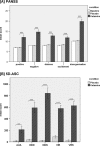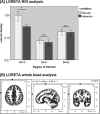Reduced auditory evoked gamma-band response and schizophrenia-like clinical symptoms under subanesthetic ketamine
- PMID: 30758327
- PMCID: PMC6785009
- DOI: 10.1038/s41386-019-0328-5
Reduced auditory evoked gamma-band response and schizophrenia-like clinical symptoms under subanesthetic ketamine
Abstract
Abnormal gamma-band oscillations (GBO) have been frequently associated with the pathophysiology of schizophrenia. GBO are modulated by glutamate, a neurotransmitter, which is continuously discussed to shape the complex symptom spectrum in schizophrenia. The current study examined the effects of ketamine, a glutamate N-methyl-D-aspartate receptor (NMDAR) antagonist, on the auditory-evoked gamma-band response (aeGBR) and psychopathological outcomes in healthy volunteers to investigate neuronal mechanisms of psychotic behavior. In a placebo-controlled, randomized crossover design, the aeGBR power, phase-locking factor (PLF) during a choice reaction task, the Positive and Negative Syndrome Scale (PANSS) and the Altered State of Consciousness (5D-ASC) Rating Scale were assessed in 25 healthy subjects. Ketamine was applied in a subanaesthetic dose. Low-resolution brain electromagnetic tomography was used for EEG source localization. Significant reductions of the aeGBR power and PLF were identified under ketamine administration compared to placebo (p < 0.01). Source-space analysis of aeGBR generators revealed significantly reduced current source density (CSD) within the anterior cingulate cortex during ketamine administration. Ketamine induced an increase in all PANSS (p < 0.001) as well as 5D-ASC scores (p < 0.01) and increased response times (p < 0.001) and error rates (p < 0.01). Only negative symptoms were significantly associated with an aeGBR power decrease (p = 0.033) as revealed by multiple linear regression. These findings argue for a substantial role of the glutamate system in the mediation of dysfunctional gamma band responses and negative symptomatology of schizophrenia and are compatible with the NMDAR hypofunction hypothesis of schizophrenia.
Conflict of interest statement
The authors declare no competing interests.
Figures





Similar articles
-
Ketamine Alters Functional Gamma and Theta Resting-State Connectivity in Healthy Humans: Implications for Schizophrenia Treatment Targeting the Glutamate System.Front Psychiatry. 2021 Jun 10;12:671007. doi: 10.3389/fpsyt.2021.671007. eCollection 2021. Front Psychiatry. 2021. PMID: 34177660 Free PMC article.
-
Glutamatergic deficit and schizophrenia-like negative symptoms: new evidence from ketamine-induced mismatch negativity alterations in healthy male humans.J Psychiatry Neurosci. 2017 Jun;42(4):273-283. doi: 10.1503/jpn.160187. J Psychiatry Neurosci. 2017. PMID: 28556775 Free PMC article. Clinical Trial.
-
Gamma Oscillations and Excitation/Inhibition Imbalance: Parallel Effects of NMDA Receptor Antagonism and Psychosis.Biol Psychiatry Cogn Neurosci Neuroimaging. 2025 Jul;10(7):681-692. doi: 10.1016/j.bpsc.2025.01.008. Epub 2025 Jan 18. Biol Psychiatry Cogn Neurosci Neuroimaging. 2025. PMID: 39832734
-
[Glutaminergic hypothesis of schizophrenia: clinical research studies with ketamine].Encephale. 2001 Jan-Feb;27(1):53-9. Encephale. 2001. PMID: 11294039 Review. French.
-
The acute effects of NMDA antagonism: from the rodent to the human brain.Brain Res Rev. 2009 May;60(2):279-86. doi: 10.1016/j.brainresrev.2008.07.006. Epub 2008 Jul 30. Brain Res Rev. 2009. PMID: 18703087 Review.
Cited by
-
Synchronization of Sensory Gamma Oscillations Promotes Multisensory Communication.eNeuro. 2019 Oct 31;6(5):ENEURO.0101-19.2019. doi: 10.1523/ENEURO.0101-19.2019. Print 2019 Sep/Oct. eNeuro. 2019. PMID: 31601635 Free PMC article.
-
Ketamine Alters Functional Gamma and Theta Resting-State Connectivity in Healthy Humans: Implications for Schizophrenia Treatment Targeting the Glutamate System.Front Psychiatry. 2021 Jun 10;12:671007. doi: 10.3389/fpsyt.2021.671007. eCollection 2021. Front Psychiatry. 2021. PMID: 34177660 Free PMC article.
-
The decoupling of structural and functional connectivity of auditory networks in individuals at clinical high-risk for psychosis.World J Biol Psychiatry. 2023 Jun;24(5):387-399. doi: 10.1080/15622975.2022.2112974. Epub 2022 Sep 9. World J Biol Psychiatry. 2023. PMID: 36083108 Free PMC article.
-
Opposite Modulation of the NMDA Receptor by Glycine and S-Ketamine and the Effects on Resting State EEG Gamma Activity: New Insights into the Glutamate Hypothesis of Schizophrenia.Int J Mol Sci. 2023 Jan 18;24(3):1913. doi: 10.3390/ijms24031913. Int J Mol Sci. 2023. PMID: 36768234 Free PMC article.
-
Associations of Plasma Glutamatergic Metabolites with Alpha Desynchronization during Cognitive Interference and Working Memory Tasks in Asymptomatic Alzheimer's Disease.Cells. 2024 Jun 4;13(11):970. doi: 10.3390/cells13110970. Cells. 2024. PMID: 38891102 Free PMC article.
References
-
- Leicht Gregor, Andreou Christina, Polomac Nenad, Lanig Clarissa, Schöttle Daniel, Lambert Martin, Mulert Christoph. Reduced auditory evoked gamma band response and cognitive processing deficits in first episode schizophrenia. The World Journal of Biological Psychiatry. 2015;16(6):387–397. doi: 10.3109/15622975.2015.1017605. - DOI - PubMed
Publication types
MeSH terms
Substances
Grants and funding
- SFB 936 C6/Deutsche Forschungsgemeinschaft (German Research Foundation)/International
- SFB 936 C6/Deutsche Forschungsgemeinschaft (German Research Foundation)/International
- SFB 936 C6/Deutsche Forschungsgemeinschaft (German Research Foundation)/International
- SFB 936 C6/Deutsche Forschungsgemeinschaft (German Research Foundation)/International
- SFB 936 C6/Deutsche Forschungsgemeinschaft (German Research Foundation)/International
LinkOut - more resources
Full Text Sources
Medical
Miscellaneous

